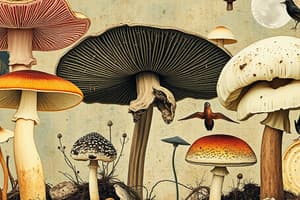Podcast
Questions and Answers
Are fungi plants, animals, or their own group (clade)?
Are fungi plants, animals, or their own group (clade)?
- Plants
- Animals
- Own group (clade) (correct)
- None of the above
Are fungi more related to plants or animals?
Are fungi more related to plants or animals?
- Animals (correct)
- Plants
- Both
- Neither
Fungi have cell walls made of chitin.
Fungi have cell walls made of chitin.
True (A)
Are fungi eukaryotic or prokaryotic?
Are fungi eukaryotic or prokaryotic?
How do fungi acquire nutrients?
How do fungi acquire nutrients?
What do we call the feeding structures made up of filaments in fungi?
What do we call the feeding structures made up of filaments in fungi?
What is the reproductive structure of fungi called?
What is the reproductive structure of fungi called?
What are spores?
What are spores?
What is the main difference between a spore and a seed?
What is the main difference between a spore and a seed?
How do fungi reproduce?
How do fungi reproduce?
What is a symbiotic relationship involving fungi and plants called?
What is a symbiotic relationship involving fungi and plants called?
Some fungi can harm plants.
Some fungi can harm plants.
What are some commercial uses of fungi?
What are some commercial uses of fungi?
Most protists are multicellular organisms.
Most protists are multicellular organisms.
How do we define a protist?
How do we define a protist?
What is phytoplankton?
What is phytoplankton?
Are bacteria unicellular or multicellular?
Are bacteria unicellular or multicellular?
What are endospores?
What are endospores?
How do bacteria reproduce?
How do bacteria reproduce?
What are the three domains of life?
What are the three domains of life?
Viruses are bacteria.
Viruses are bacteria.
Why shouldn't antibiotics be taken over a prolonged period of time?
Why shouldn't antibiotics be taken over a prolonged period of time?
Flashcards are hidden until you start studying
Study Notes
Fungi
- Fungi are a distinct group of organisms, separate from plants and animals.
- They are more closely related to animals due to the presence of chitin in their cell walls, analogous to the exoskeletons of insects.
- Fungi possess eukaryotic cells, indicating a complex cellular structure with a nucleus.
- They are heterotrophic, relying on absorption to obtain nutrients, contrasting with autotrophs like plants.
- Fungi play a critical role as decomposers, recycling nutrients in ecosystems; their absence would lead to the accumulation of organic matter.
- Feeding structures composed of hyphae form the mycelium, the main body of the fungus.
- Fruiting bodies, such as mushrooms, are reproductive structures that release spores for reproduction, produced both sexually and asexually.
- Spores are unicellular and can reproduce without mating; unlike seeds, they are microscopic and not planted in the ground.
- While a single fruiting body can produce billions of spores, limited resources restrict fungal growth.
Symbiosis and Relationships
- Fungi form mutually beneficial relationships with plants via mycorrhizae, aiding nutrient and water absorption in exchange for sugars from photosynthesis.
- They also partner with photosynthetic organisms like algae or bacteria, providing protection and minerals in exchange for nutrients.
- Some fungi can act as parasites, extracting nutrients from plants and animals, potentially causing harm.
Commercial Importance
- Fungi are commercially valuable; they are consumed as food, used in the production of antibiotics like penicillin, and utilized in fermentation processes (bread, beer, cheese).
Protists
- Protists are defined as eukaryotic organisms that are not categorized as plants, animals, or fungi, resulting in high diversity.
- Most protists are unicellular and can be classified as plant-like (photosynthetic), animal-like (heterotrophic), or fungus-like (absorptive).
- Phytoplankton are photosynthetic protists, crucial to aquatic ecosystems as they form the base of the food chain, requiring sunlight for photosynthesis.
- Although some protists are edible (kelp, seaweed), their classification aligns them more closely with algae than traditional plants.
Bacteria and Archaea
- Bacteria are unicellular prokaryotes with a cell wall but lack organelles and a nucleus; archaea are similar but adapted to extreme environments.
- Both bacteria and archaea are classified by characteristics such as shape, movement, and energy acquisition methods.
- Bacteria serve as decomposers, recycling nutrients from dead organic matter.
- Endospores formed by bacteria allow survival under unfavorable conditions by encasing DNA.
- Bacteria reproduce asexually through binary fission, with genetic exchange occurring via conjugation to enhance diversity.
Health and Ecology
- Good bacteria, such as nitrogen-fixing species, contribute to ecosystem health and human food production.
- Bad bacteria can lead to infections; common control measures include antibiotics, physical removal, and sanitary practices.
- Bacterial infections can be treated with antibiotics, but misuse can lead to resistance.
- Vaccines provide immunity by exposing the body to harmless forms of pathogens, while antibiotics target active bacterial infections.
Viruses
- Viruses are distinct from bacteria; they consist of DNA encapsulated in a protein coat and do not possess living cellular structures.
- Antibiotics are ineffective against viruses, highlighting the importance of distinguishing between bacterial and viral infections for treatment.
Evolution
- Continuous study of bacteria and their resistance to antibiotics underscores the relevance of evolutionary principles in medicine and ecology.
Studying That Suits You
Use AI to generate personalized quizzes and flashcards to suit your learning preferences.




